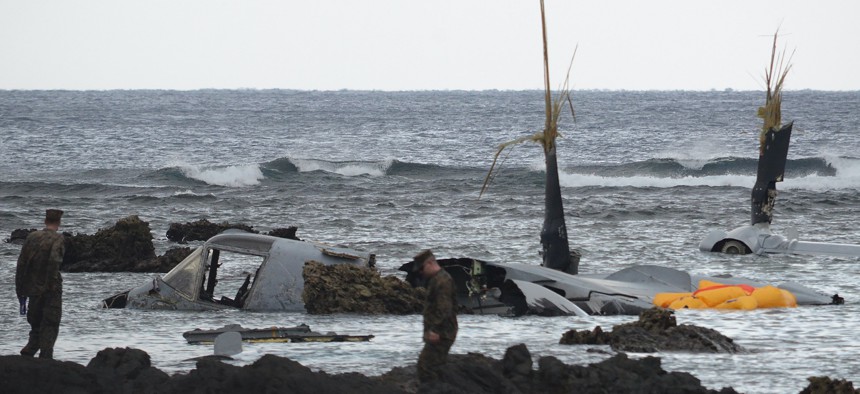
The wreckage of a U.S. Marine MV-22 Osprey tilt-rotor aircraft is seen as the tide recedes on the coast of Okinawa, Japan, on December 14, 2016. AFP via Getty Images / JIJI PRESS
Can a New Aviation Safety Office Avoid Its Predecessors’ Mistakes?
And can it help salve annual mishap spikes caused by Congressional inaction?
When a military aircraft crashes, how the data is reported can vary widely from service to service, which makes it harder to spot trends. A new Pentagon office is trying to standardize this reporting—and keep military aircraft crashes from rising again.
The creation of the Joint Safety Council, established June 28 by Deputy Defense Secretary Kathleen Hicks, fulfilled a primary recommendation of an independent commission into aviation accidents. The commission found that senior leaders’ inattention to safety was one reason aircraft accidents killed 224 pilots and crew between 2013 and 2020.
But if this council is to be effective, it will have to do better than its predecessor, the Defense Safety Oversight Council, which did not meet between 2013 and 2018 to review accidents, the independent commission found.
“It just wasn't a priority of the leaders over time,” said Shawn Skelly, assistant defense secretary for readiness, a retired commander who flew S-3 Vikings for the Navy and who is now leading the Pentagon’s latest safety council effort. When she took the readiness post in 2021, Skelly asked when the last meeting had taken place, and learned the mandated safety forum had been held only three times in the last 11 years.
The new council, which will also look at maritime and tactical vehicle accidents, will meet at least twice a year with service undersecretaries and vice chiefs of staff to keep high-level attention on preventing accidents.
One trend the National Guard has already identified is that July and August can be some of the most dangerous months for flying. There are several potential reasons, including summer unit rotations and moves that can reduce the amount of time spent training.
But Congress’ recent inability to pass federal budgets on time also takes a deadly toll, the commission found. Late budgets lead unit commanders to reduce training to preserve funds, and when they do allow pilots to fly, may restrict them to basic flights to reduce risk. Then, when the budget bills are finally passed and money flows in, the unit has to spend it—or lose it— in the the fiscal year’s remaining months. That can mean a rush of flights for pilots who may not have had consistent training in the months before.
While basic flights count toward required training hours, they don’t prepare a crew for the rigors of military aviation. The lack of readiness and flight hours contributed to the 2018 collision of a U.S. Marine Corps F/A-18 Hornet and KC-130J tanker off Japan that killed six Marines.
A former naval flight officer, Skelly said she’s been hearing directly from crews about these training concerns. She said her office will seek to address the wider causes.
“Flight hours for flight hours’ sake runs out of effect pretty quickly,” she said. “They should also include quality, mission-focused training to ensure we build warfighting readiness.”
The military identifies its most serious accidents into three types: Class A, the most serious, involves death or permanent disability to a crew member or destruction of aircraft. Class B involve injury to a service member or up to $2 million in damage to an aircraft, while Class C includes injury and up to $600,000 in aircraft damage.
Summer spike
July and August were the most dangerous months for aircrews in recent years, according to Defense Department data provided to Defense One on Class A through Class C incidents from fiscal years 2019 through March 2022.
Each of those fiscal years began without a budget in place. Instead, Congress passed continuing resolutions that froze spending at the previous year’s level. Months passed before budget bills were passed.
Fiscal 2022—the current one—began the same way last Oct. 1, with a continuing resolution standing in for an actual budget. Six months passed before the defense appropriations act was signed into law in mid-March. True to form, the month proved particularly dangerous for aviators. In March 2022, the Navy, Marine Corps and Army reported 57 accidents—more than half as many as in the previous three Marches combined.
Data standardization
Skelly said the differences in service reports about accidents make it harder to identify common causes. Safety officers must manually adjust each reports’ data as they compile it.
“When I learned that our numbers weren't roughly comparable, I was, frankly, a little shocked,” she said.
Under the new reporting requirements, Skelly said, each service will use the same reporting fields and pull-down options when submitting their accident reports. The data will still have limitations. For example, it won’t show how many training hours a unit or pilot had before an accident or what type of training they received, such as simulator flight hours versus in-air advanced night flying. Such details might be captured in a future data system, Skelly said.





